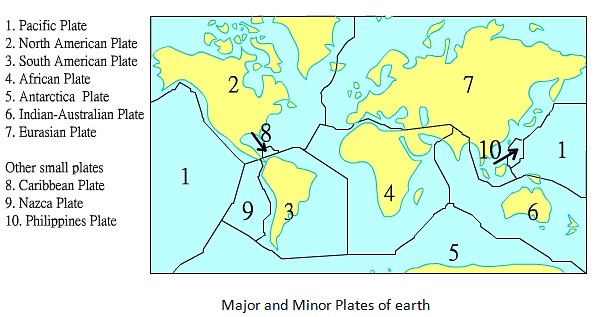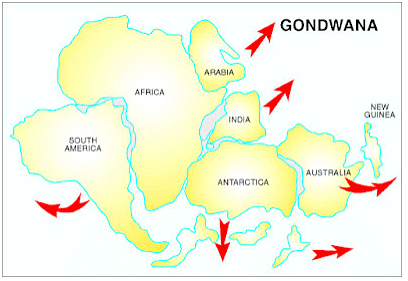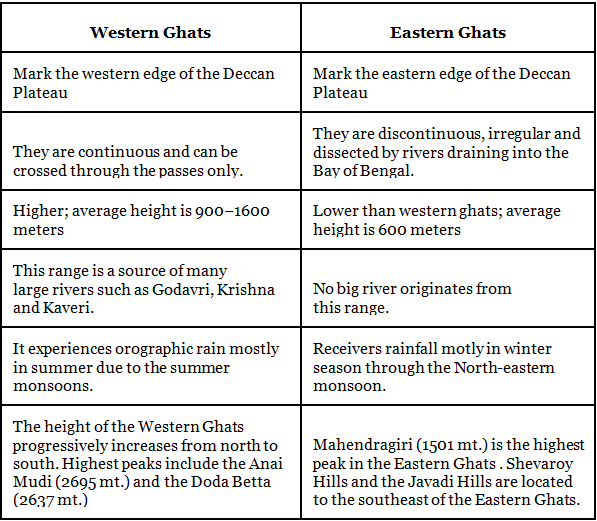UPSC Exam > UPSC Notes > NCERT Video Summary: Class 6 to Class 12 (English) > NCERT Summary: Physical Features of India
Physical Features of India Summary Class 9 Social Science Chapter 2
Introduction
- India is a vast country with varied landforms which has all major physical features of the earth i.e. mountains, plains, deserts, plateaus and islands.
How these physical features formed?
- There are some theories behind the formation of physical features. One such theory is the “Theory of Plate Tectonics”.
What is “Theory of Plate Tectonics”?
- This theory explained that upper part of earth called crust divided into seven major and some minor plates called tectonics plates.

- The movement of these plates builds up stresses within the plates and also the continental rocks above which results in folding, faulting and volcanic activity.
- The movements can be classified into three types broadly:
- Convergent Boundary: When some plates come towards each other, form convergent boundary. It may lead to either collide and crumble, or one may slide under the other.
- Divergent Boundary: When some plates move away from each other, it form divergent boundary.
- Transform Boundary: When some plates move horizontally past each other and form transform boundary.
- The movements of the plates alongwith the processes such as weathering, erosion and deposition have changed the position and size of the continents over millions of years and also responsible for the evolution of the present landform features of India.
- The oldest landmass i.e., Peninsula part of India was a part of the Gondwana land.
What is Gondwana land?
There was a time when India, Australia, South Africa, South America and Antarctica were one single land mass known as Gondwana land. It was the southern part of super continent Pangea. Northern part was known as Angara land.
The below-detailed picture of Gondwana land will make you more clear:
Formation of Himalayas
- The earth crust was divided into a number of pieces by convectional currents.
- The Indo-Australian Plate separated from the Gondwana land and drifted towards north which resulted in the collision of the plate with the much larger Eurasian Plate.
- Due to this collision, the sedimentary rocks which were accumulated in the geosyncline known as the Tethys were folded which resulted in the formation of mountain system of western Asia and Himalaya.
Formation of Northern Plain
- The uplift of Himalaya from Tethys sea and settling of the northern flank of the peninsular plateau created a large basin.
- In due time, gradually the basin got filled with deposition of sediments by the rivers flowing from the mountains in the north and the peninsular plateau in the south which created a flat land of extensive alluvial deposits known as northern plains of India.
- Geologically, the Peninsular Plateau are most stable land blocks as it was one of the ancient landmasses on the earth’s surface.
- The Himalayas and the Northern Plains are the most recent landforms.
- The Himalayan mountain form an unstable zone as it has very youthful topography with high peaks, deep valleys and fast flowing rivers.
Major Physiographic divisions of India
The Himalayan Mountains
- It is geologically young and structurally folded mountains which run along the northern borders of India.
- The ranges run from west (from Indus) to east direction (to the Brahmaputra) covering a distance of about 2,400 Km representing loftiest peaks in the world.
- Width varies from 400 Km in Kashmir to 150 Km in Arunachal Pradesh. Altitude (Height) variations is greater in the eastern half than those in the western half.
- Longitudinal divisions of Himalayas:
- The Great or inner Himalayas or the 'Himadri'
- The lesser Himalaya or 'Himachal'
- The Shiwaliks
- The Great or inner Himalayas or the 'Himadri':
- It is the northernmost range and most continuous range consisting of the loftiest peaks with an average height of 6,000 metres.
- It contains all the famous peaks. The folds are asymmetrical in nature.
- The basic part of this Himalayas is composed of granite.
- It is perennially snow bound, and a number of glaciers descend from this range.
- The lesser Himalaya or 'Himachal':
- It lies south of the Himadri forms the most rugged mountain system.
- It is mainly composed of highly compressed and altered rocks.
- The height varies between 3,700 and 4,500 metres and the average width is of 50 Km.
- Longest and most important ranges are PirPanjal range and Dhaula Dhar and the Mahabharat ranges.
- Famous valley of this range are the Kashmir, the Kangra and Kullu Valley in Himachal Pradesh.
- Also, this range is famous for hill stations.
- The Shiwaliks:
- This is the outermost range of the Himalayas.
- They extend over a width of 10-50 Km and have a height varying between 900 and 1100 metres.
- It is composed of unconsolidated sediments brought down by rivers from the main Himalayan ranges.
- These valleys are covered with thick gravel and alluvium.
- The longitudinal valley lying between lesser Himalaya and the Shiwaliks are known as Duns.
- Dehra Dun, Kotli Dun and Patli Dun are some of the well-known Duns.
- Himalayas divisions on the basis of regions from east to west (divisions have been made by the river valleys):
- Punjab Himalayas: The part of Himalayas lying between Indus and Satluj. From west to east respectively, regionally known as Kashmir and Himachal Himalaya.
- Kumaon Himalayas: The part of the Himalayas lying between Satluj and Kali rivers.
- Nepal Himalayas: The part lying between Kali and Tista rivers.
- Assam Himalayas: The part lying between Tista and Dihang rivers.
- The Purvachal or Eastern hills and mountains:
- The mountain ranges of Eastern India. It is marked by the Brahmaputra.
- The Himalayas bend sharply to the south and spread along the eastern boundary of India after the Dihang gorge.
- These hills running through the north-eastern states i.e., Arunachal Pradesh, Nagaland, Manipur, Mizoram, Tripura, and eastern Assam states and are mostly composed of strong sandstones which are sedimentary rocks.
- Hills are covered with dense forests. It comprises the Patkai hills, the Naga hills, Manipur hills and the Mizo hills.
The Northern Plains
- The northern plain has been formed by the interplay of three major river systems namely- the Indus, the Ganga and the Brahmaputra along with its tributaries.
- It is formed of Alluvial soil. The vast basin lying at the foothills of the Himalaya is deposited with alluvium (fine particles of silt and clay and larger particles of sand and gravel) over a million of years and formed this plain.
- Area of Northern plain: 7 lakh sq. km. Length of Northern plain: 2400 km. Breadth of Northern plain: 240 to 320 km.
- It is densely populated region. It is agriculturally very productive region of India due to rich soil cover combined with adequate water supply and favourable climate.
- The rivers coming from northern mountains brought a huge amount of eroded soil which help in the depositional work.
- In the lower course, due to gentle slope, the velocity of the river decreases which results in the formation of riverine islands (An Island formed by the river).
- Also, in lower course rivers split into numerous channels due to the deposition of silt known as distributaries.
- The Northern Plain is broadly divided into three parts
- The Punjab Plains - The Western part of the Northern Plain, formed by the Indus and its tributaries, the larger part of this plain lies in Pakistan
- The Ganga Plains: It extends between Ghaggar and Tista rivers. spread over the states of north India, Haryana, Delhi, U.P., Bihar, party Jharkhand and West Bengal.
- The Brahmaputra Plains: Lies in the east of Ganga plain, particularly in Assam.
- Northern Plain is not flat land. The vast plains also have diverse relief features.
- Northern plains can be divided into four regions (according to the variations in relief features)
- Bhabar: laying at the foot of Shivalik, a narrow 8 to 16 km wide belt of pebbles.
- Terai: lying next to Bhabar, a wet and marshy area with wildlife and forests.
- Bhangar: Older alluvium plain which rises above the level of the flood plains.
- Khadar: Younger alluvium of the flood plains.
Peninsular Plateau
- The Peninsular plateau is a tableland composed of the old crystalline, igneous and metamorphic rocks.
- It was formed due to the breaking and drifting of the Gondwana land.
- The plateau consists of two broad divisions:
- The Central Highlands
- The Deccan Plateau
- The Central Highlands: It lies to the north of the Narmada river covering a major area of the Malwa plateau.
- The Vindhyan range is bounded by the Central Highlands on the south and the Aravalis on the northwest.
- The further westward extension gradually merges with the sandy and rocky desert of Rajasthan.
- Rivers in this area: the Chambal, the Sind, the Betwa and Ken.
- The Central Highlands are wider in the west but narrower in the east.
- The eastward extensions of this plateau are locally known as the Bundelkhand and Baghelkhand.
- The Chotanagpur plateau marks the further eastward extension, drained by the Damodar river.
- The Deccan Plateau: It is a triangular landmass that lies to the south of the river Narmada.
- The Satpura range bound its broad base in the north while the Mahadev, the Kaimur hills and the
- Maikal range form its eastern extensions.
- It is higher in the west and slopes gently eastwards.
- An extension of Deccan Plateau is also visible in the northeast– locally known as the Meghalaya, Karbi-Anglong Plateau and North Cachar Hills.
- It is separated by a fault from the Chotanagpur Plateau.
- Three Prominent hill ranges from the west to east are the Garo, the Khasi and the Jaintia Hills.
- A distinct feature of the peninsular plateau is the black soil area known as Deccan Trap.
- The Western Ghats and the Eastern Ghats mark the western and the eastern edges of the Deccan Plateau respectively.

The Indian Desert
- The Indian desert lies towards the western margins of the Aravali Hills.
- It is a land of undulating topography covered with sand dunes.
- This region receives very low rainfall below 150 mm per year.
- It has arid climate with low vegetation cover.
- Luni is the only large river in this region.
- Barchans (crescent shaped dunes) cover larger areas but longitudinal dunes become more prominent near the Indo-Pakistan boundary.
The Coastal Plains
- The narrow coastal strips flank the Peninsular Plateau, running along the Arabian Sea on the west and the Bay of Bengal on the east.
- It consists of three sections:
- Northern part of the coast is called the Konkan (Mumbai – Goa)
- Central stretch is called the Kannad Plain
- Southern stretch is called the Malabar coast.
- The plains along the Bay of Bengal (east part) are wide and level.
- The northern part is known as the Northern Circar, while the southern part is known as the Coromandel Coast.
- Large rivers such as the Mahanadi, the Godavari, the Krishna and the Kaveri have formed extensive delta on eastern coast.
- Lake Chilika is an important feature along the eastern coast.
The Islands
- The Lakshadweep Islands group in the Arabian Sea is close to Kerala.
- This group of islands is composed of small coral islands.
- The Lakshadweep Islands were earlier known as Laccadive, Minicoy and Amindive.
- It covers small area of 32 sq km.
- Kavaratti island is the administrative headquarters of Lakshadweep.
- The Pitti island, which is uninhabited, has a bird sanctuary.
- The Andaman and Nicobar Islands are an elongated chain of islands located in the Bay of Bengal.
- They are bigger in size and are more numerous and scattered.
- The entire group of islands is divided into two broad categories – The Andaman in the north and the Nicobar in the south.
- These islands are an elevated portion of submarine mountains.
How these diverse physical features useful for India:
- The mountains are the major sources of water and forest wealth.
- The northern plains are the granaries of the country.
- The plateau is a storehouse of minerals, which has played a crucial role in the industrialisation of the country.
- The coastal region and island groups provide sites for fishing and port activities.
The document Physical Features of India Summary Class 9 Social Science Chapter 2 is a part of the UPSC Course NCERT Video Summary: Class 6 to Class 12 (English).
All you need of UPSC at this link: UPSC
|
493 videos|387 docs
|
FAQs on Physical Features of India Summary Class 9 Social Science Chapter 2
| 1. What are the major physical features of India? |  |
Ans. India is characterized by several major physical features, including the Himalayan mountain range in the north, the Indo-Gangetic plains, the Deccan Plateau, and the coastal plains along the Arabian Sea and the Bay of Bengal. These features greatly influence the country's climate, vegetation, and agricultural practices.
| 2. What is the significance of the Himalayan mountain range in India? |  |
Ans. The Himalayan mountain range plays a crucial role in India's physical geography. It acts as a natural barrier, protecting the country from cold winds from Central Asia. The Himalayas also serve as a major source of rivers, providing freshwater for irrigation, hydroelectric power generation, and overall sustenance of life in the region.
| 3. How do the physical features of India influence its climate? |  |
Ans. The physical features of India greatly influence its climate. For example, the Himalayas block the cold winds from the north, resulting in a diverse climate across the country. The presence of the Thar Desert in the northwest affects the monsoon winds, leading to arid conditions in certain regions. The coastal plains, on the other hand, experience a maritime climate due to their proximity to the sea.
| 4. What is the importance of the Indo-Gangetic plains in India? |  |
Ans. The Indo-Gangetic plains are highly fertile and support intensive agriculture. With their rich alluvial soil, these plains are known as the "breadbasket of India." They are home to major agricultural practices, including rice and wheat cultivation, and support a significant proportion of the country's population.
| 5. How do the physical features of India contribute to its cultural diversity? |  |
Ans. The physical features of India have played a significant role in shaping its cultural diversity. The varied geographical conditions have led to the emergence of different ethnic groups, languages, and lifestyles across the country. The availability of diverse resources and natural landscapes has also influenced the traditional occupations, arts, and crafts of different regions, contributing to India's vibrant cultural heritage.
Related Searches
















